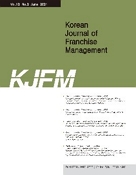 E-ISSN : 2508-4593
E-ISSN : 2508-4593
HAN, Youngwee
Abstract
Purpose: Waiting occured frequently in the service industry. Because waiting time is perceived as a loss by customers, perceived waiting time affects positive and negative responses to restaurants. If the waiting time is perceived as long, the waiting receptivity to accept the wait may also decrease. Therefore, restaurant stores need to increase waiting satisfaction so that customers can feel the waiting time shorter. Therefore, in this study, the effect of perceived waiting time and waiting satisfaction of customers visiting Taiwanese restaurant companies on waiting acceptability, emotions (positive and negative emotions) and satisfaction is investigated. Research design, data, and methodology: This study examines the structural relationship between perceived latency, waiting satisfaction, emotion, and satisfaction. To verify the purpose of this study, a research model and hypothesis were developed. The questionnaire items were modified and used according to the content of this study based on previous studies. All configurations were measured with multiple items tested and developed in previous studies. Data collected from 407 Taiwanese restaurant customers were analyzed using SPSS 22.0 and SmartPLS 3.0 programs. Confirmatory factor analysis was performed to measure the reliability and effectiveness of the measurement tool. Structural model analysis was performed to validate the study model. Results: The study results are as follows. Perceived waiting time was found to have a positive effect on negative emotions. In addition, it was found that waiting acceptability had a negative effect on negative emotions, and had a positive effect on positive emotions and customer satisfaction. Positive emotions were found to have a significant positive effect on customer satisfaction. Also, waiting satisfaction was found to have a positive effect as a moderating variable on the relationship between perceived waiting time and waiting acceptability. Conclusion: According to the results of this study, perceived waiting time was found to have a negative effect on eating out consumers. However, if the waiting time is satisfied, waiting time will increase the waiting time acceptability. Therefore, if customers are satisfied with the waiting environment by improving the quality of the waiting environment, it will be possible to establish a marketing <sup>*</sup>strategy<sup>*</sup> that stimulates the positive effect of the perceived waiting time.
- keywords
- Perceived Waiting Time, Waiting Acceptability, Emotions, Satisfaction, Waiting Satisfaction, Tiwan Restaurant
- Downloaded
- Viewed
- 0KCI Citations
- 0WOS Citations













